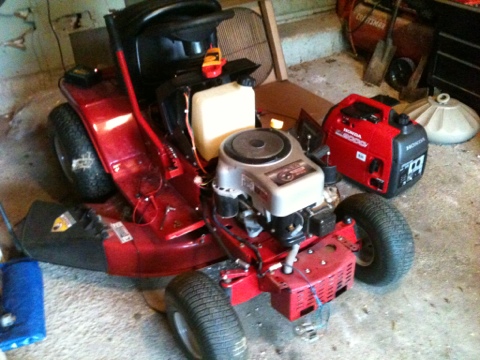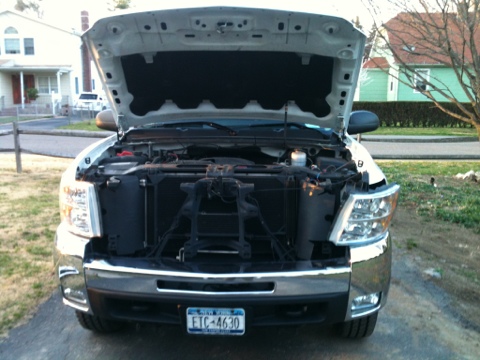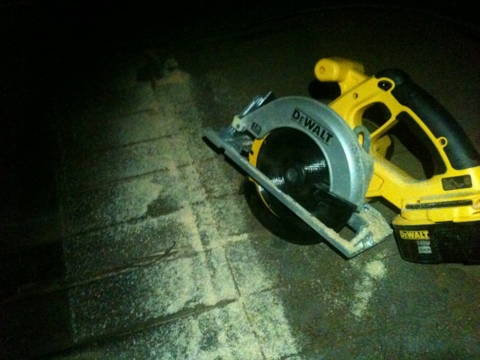As part of our ongoing renovations I needed to replace the old outlet on the back porch, which is part of a bigger project I’ve had on the back burner for a while. The wiring in the garage was not up to our standards and so the only way I could replace the outlet in good conscience was to re-wire the entire garage. As luck would have it I had run a new feeder line from the panel up to the attic above the garage when we were doing work in the kitchen and dining room. The outlet outside in the back was the first order of business but also on the list were the ceiling outlet for the garage door, a new light, a replacement outlet inside the garage, a new outlet and light switch by the rear door, a new outlet in the front and a new outlet and switch for the exterior lights on the garage. I’m already exhausted from just writing that list. The good part of replacing the old outlets is that the Sheetrock in the back of the garage was bashed to hell already so it was easy access.

This is after I made a straight cut across the whole damaged area in anticipation of repairing it.
As with most wiring projects the real work is fishing the cable through the walls, at least with the unfinished attic I was able to fully access the wiring from above, and pull most of the wires through where the old wires were. Being a garage there is also no insulation besides the wall against the interior of the house, so that helps make things a little easier as well.
There were a number of challenges involved but I won’t chronicle them all here, instead I’ll move on to the fun stuff.
Over the last few months I’ve been stocking up on some Z wave items to continue our home automation project. The big one I was exited about was the garage door integration with Z wave.
First off, the fact that an integrated product to do this does not exist seems crazy since the internet is full of accounts of people going through this process. Instead, you kind of have to figure out on your own. This required two separate pieces of equipment; a garage door sensor and a relay module.
The sensor is used to indicate whether the door is closed or open, or more accurately closed or not closed. My brother Chris actually was over to help with this part of the installation, which wasn’t too labor intensive but it was good to have another person to bounce ideas off and make sure things weren’t interfering with each other. The sensor works through means of a glass reed switch, which is basically a switch that connects a circuit if it senses a magnet next to it. This is the basis for most door and window sensors used in alarm systems.
The trick was placing it somewhere where the magnet would be able to safely travel with the garage door without interfering with something and mounting the sensor where it wouldn’t be impacted by any of the moving parts. The sensitivity of the magnet switch is pretty precise so the magnet needs to land within a quarter inch of the sensor when it is closed. We played around a bit and found a spot on the frame of the garage door where we could mount the sensor and have the magnet on the edge of one the door panels to just barely scrape by.
I had previously joined the sensor to the Z wave network and tested its functionality prior to mounting it so once it was up we could see right away that it was working. As of now the sensor only sees itself as a door sensor intended for an alarm system environment, which is a little odd because it gives its status as “Tripped”: Yes or No. If the sensor is not detecting the magnet it is considered tripped, which translates to open. Like I said though, a limit of this system is that it can’t really say it’s open, just not closed. If the door was open one inch it would be “tripped”. Many people recommend a camera to confirm whether the door is actually closed or open, which kind of negates the need for sensor, in my opinion. I’m sure we’ll get one anyway, at some point.
We also installed a Z-wave contact closure relay that I wired in to the garage door opener which actually allows us to open or close the door from the remote app. It functions by briefly connecting two conductors on the opener, mimicking what would happen if you hit the button inside the garage. It actually works pretty well, and any shortcomings it does have I think are more of a symptom of the app we use rather than the hardware or installation.
So now that this project is complete we can plug stuff in without having to use a ground lifter and if we go somewhere and think “oh no! Did I leave the garage door open?!” We can check, and if we did we can close it. As an added bonus if I’m too dumb to even realize I left the door open, I was able to program in a timer that emails and texts me if the door is open longer than a half hour.

















